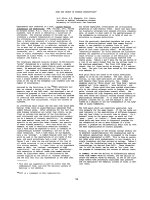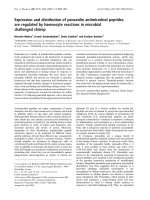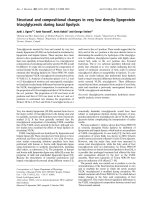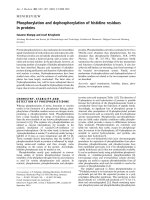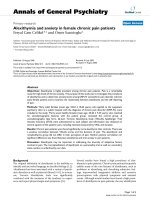Báo cáo y học: "Prediabetes and prehypertension in disease free obese adults correlate with an exacerbated systemic proinflammatory milieu." pptx
Bạn đang xem bản rút gọn của tài liệu. Xem và tải ngay bản đầy đủ của tài liệu tại đây (239.49 KB, 5 trang )
RESEARC H Open Access
Prediabetes and prehypertension in disease free
obese adults correlate with an exacerbated
systemic proinflammatory milieu
Alok K Gupta
*
, William D Johnson
Abstract
Background: Obesity is a pro-inflammatory state frequently associated with widespread metabolic alterations that
include insulin resistance and deregulation of blood pressure (BP). This cascade of events in some measure
explains the susceptibility of obese adults for co-morbid conditions like diabetes mellitus and hypertension.
Hypothesis: We hypothesized that an elevated systemi c proinflammatory burden correlates with dysglycemia and
deregulated blood pressure.
Methods: We analyzed the screening anthropometric and laboratory measures from healthy disease free obese
adults (n = 35; women (W) 27, men (M) 8) in a weight loss study.
Results: Healthy obese normoglycemic (fasting serum glucose: FSG <100 mg/dL) women and men compared with
healthy obese with prediabetes (FSG 100-125 mg/dL) had no significant differences for age (Mean ± SD: 52 ± 12
vs. 56 ± 9 y), weight (95 ± 11 vs. 99 ± 13 kg), or waist circumference (108 ± 10 vs. 108 ± 11 cm). Normoglycemic
group (n = 24; W = 19, M = 5) had normal FSG 92 ± 4 mg/dL, HbA1c 5.4 ± 0.3%, BP 118/75 mm Hg, but had
elevated high sensitivity C-reactive protein (hs CRP) 3.7 ± 3 mg/L and fibrinogen 472 ± 76 mg/dL. The group with
prediabetes (n = 11; W = 8, M = 3) with significantly higher FSG (106 ± 3 mg/dL; p < 0.0001), HbA1c (5.9 ± 0.5%; p
< 0.002), had prehypertension (BP: 127/80 mm Hg) and significantly higher hs CRP (16.9 ± 9 mg/; p < 0.0001) and
fibrinogen (599 ± 95 mg/dL; p < 0.0002).
Conclusions: In otherwise healthy disease free obese adults, a higher degree of systemic inflammation is
associated with prediabetes and prehypertension.
Introduction
Overweight and obese adults in comparison to their
non-obese counterparts, have a greater susceptibility for
subsequently developing diabetes mellitus and/or hyper-
tension [1,2]. Obesity is a recognized pro-inflammatory
state prone for broad alterations of the metabolic milieu,
which include increased insul in resistance a nd loss of
blood pressure control [3]. The effect of systemic
inflammation and insulin resistance upon blood gluco se
concentration and blood pressure control, early in the
course of the developing overweight and obese condi-
tion, prior to the o nset of overt diabetes mellitus and/or
hypertension, is unclear. It is also not transparent
whether the pro-inflammatory state determines the
insulin resistant condition or insulin resistance causes
increased systemic inflammation.
An expanding visceral adipose tissue compartment [4]
(clinical correlate: increased waist circumference), is an
altered distribution pattern that is believed to impair
adipose tissue function and increase cardiovascular dis-
ease (CVD) risk [ 5]. The altered adipose tissue secre-
tions with a uto, para and endocrine effects, appear to
influence multiple metabolic pathways, including those
that modulate glycemia and blood pressure control [6].
This altered adipose tissue [7-9] secretory activity can
unhinge the anti-inflammatory and pro-inflammatory
balance favoring inflammation, fostering dysglycemia
(clinical correlate: prediabetes), and disrupting blood
pressure control (clinical correlate: prehypertensio n).
* Correspondence:
Pennington Biomedical Research Center, Louisiana State University System,
Baton Rouge, Louisiana, USA
Gupta and Johnson Journal of Inflammation 2010, 7:36
/>© 2010 Gupta and Johnson; licensee BioMed Central Ltd. This is an Open A ccess article distr ibuted u nder the terms of the Creativ e
Commons Attribution License ( which permits unrestricted use, distri bution, and
reproduction in any medium, provided the original work is properly cited.
The escalating inflammation can also result in abnormal
circadian blood pressure variabili ty and endothelial dys-
function (unpublished observations, currently in review),
which over the long term may lead to cardiovascular
disease [10].
Prediabetes and prehypertension in healthy overweight
or obese adults can thus be early markers of an
expanded visceral adipose tissue driven adipose tissue
dysfunction (systemic inf lammation) prior to the onset
of frank diabetes and/or hypertension. In the present
study, we hypothesized that an increasing systemic
proinflammatory burden correlates with dysglycemia
and deregulated blood pressure. We investigated this
hypothesis by comparing disease free obese normoglyce-
mic women and men with disease free obese adults with
prediabetes.
Methods
Study Design
Screening measures from healthy disease free obese
subjects (n = 35) screening for a weight loss study
at the Outpatient Clinic, Pennington Biomedical
Research Center (PBRC) were used for this study. The
Pennington Biomedical Research Center is a campus
of the Louisiana State University System and conducts
basic, clinical and population research. The research
enterprise at the Center includes 80 faculty and more
than 40 post-doctoral f ellows who comprise a network
of 57 laboratories supported by lab technicians,
nurses, dieticians, and support personnel, and 19
highly specialized core service facilities. The Center’ s
nearly 600 employees occupy seve ral buildings on the
234-acre campus.
Study subjects
Healthy disease free obese non-smoking men and
women between 35-75 years, with no personal history of
or ongoing treatment with chronic intake of prescription
medications (like for diabetes mellitus, hypertension or
other cardaic, renal, gastro-intestinal, pulmonary, or any
other systemic disease process). All subjects had read,
understood, and signed a PBRC i nstitutional review
board approved consent form. The subjects were strati-
fied into two groups: the group with normoglycemia
was compared with the group with prediabetes.
Demographic, Anthropometric and Laboratory measures
Standard demographic and anthropometric measures
were obtained for all subjects. Waist circumference (a
surrogate marker for central adiposity), serum high sen-
sitivity C reactive protein (hs CRP) and fibrinogen (for
assessment of systemic i nflammation), fasting serum
glucose and HbA1C (for assessing glycemic status) and
fasting complete lipid profile (for assessing serum lipid
sub-fractions and obtaining cardaic risk ratios) were
obtained. Serum uric acid, total white blood cell count
(as measures for systemic inflammation), Lp(a), ApoB
and ApoA1 (as measures for cardiovascular risk) were
also obtained.
Normoglycemia, prediabetes and prehypertension
Normoglycemia was defined as f asting serum glucose
(FSG) less than 100 mg/dL a nd prediabetes as FSG
more than 100 mg/dL but less then 126 mg/dL (Predia-
betes: impaired fasting glucose (IFG) and/or impaired
glucose tolerance (IGT): American Diabetes Association
diagnostic criteria [11]). A glycosylated hemoglobin
(HbA1C) between 5.7 and 6.4% (recently approved by
the ADA) was also used for the diagnosis of prediabetes.
Prehypertension was diagnosed based on the mean (of
two successive assessments after a 5 minute rest) resting
clinic blood pressure (BP) measures for systolic blood
pressure (SBP) >120 but <139 and/or diasto lic blood
pressure (DBP) >80 but <89 mm Hg (Prehypertension:
Joint National Commission 7 criteria [12]).
Systemic inflammation, cardiovascular risk evaluation
Systemic inflammation was measured with serum con-
centrations of high sensitivity C reactive protein (hs
CRP: reference range: 0.0-3.0 mg/L), fibrinogen (reference
range: 150-450 mg/dL), uric acid (reference range: 4.0-8.5
mg/dL) and total white blood cell count (reference range:
3.5-11.0 10
3
/μl). Glycemic stat us was assessed with FSG
(desirable <100 mg/dL)andHbA1C(desirable <5.6%).
A fasting lipid profile was obtained for total cholesterol
(total-C: desirable <200 mg/dL), triglycerides (TG: des ir-
able <150 mg.dL), high-density cholesterol, (HDL-C:
desirable>40and>50mg/dLinmenandwomen,
respectively) and low-density cho lesterol, (LDL-C: desir-
able <130 mg/dL). Cardaic risk ratios were calculated
(average reference range: total-C to HDL-C of 5 and
LDL-C to HDL-C of 3). Serum concentrations of L p(a)
(reference range: 1-30 mg/dL), apolipoprotein A (Apo A:
reference range: 110-205 mg/dL), apolipoprotein B (Apo
B: reference range: 55-105 mg/dL), the major apoproteins
for HDL-C and LDL-C, respectively were also measured.
Results
Table 1 describes the demogr aphic, anthropometric and
laboratory measures for all the otherwise healthy disease
free obese adults included in the study (n = 35; 27
women and 8 men). These disease free, predominantly
women, were middle aged, obese, and displayed central
obesity. They exhibited good glycemic control (FSG: 96
± 8 mg/dL, HbA1C: 5.6 ± 0.4%), had slight elevation of
systolic blood pressure, but had normal diastolic blood
pressure and heart rate (BP121 ± 13/77 ± 7 mm Hg,
heart rate: 69 ± 9 beats per minute).
Gupta and Johnson Journal of Inflammation 2010, 7:36
/>Page 2 of 5
Their fasting lipid profile, on average, included a
slightly elevated total-C, TG and LDL-C (215 ± 41,153
± 83,131 ± 38 mg/dL, respectively) with normal HDL- C
(53 ± 13 mg/dL). Their cardaic risk ratios, however,
were below the average range (4.2 ± 1.3 and 2.6 ± 1.0,
respectively). Their Lp(a) and ApoB levels were slightly
above the upper limits of normal (38 ± 34 and 112 ± 24
mg/dL), while the ApoA1 levels were with in normal
limits (166 ± 28 mg/dL), attesting to a normal lipopro-
tein metabolism, with an average cardiovascular d isease
risk.
They had accentuated systemic pro-inflammat ory pro-
files with high serum hs CRP and fibrinogen concentra-
tions (7.8 ± 8.3 mg/L and 512 ± 101 mg/dL, respectively).
Their uric acid and total white blood cell count (5.4 ± 1.1
mg/dL and 6.74 ± 1.7 10
3
/μl) were normal.
Table 2 details the cardiometabolic risk profile in
healthy disease free obese subjects with normoglycemia
(n = 24; 19 women, 5 men), compared with those with
prediabetes (n = 11; 8 women, 3 men). Differences in
means between groups (normoglycemia vs. prediabetes)
were not s ignificantly di fferent for age (Mean ± SD: 52 ±
12vs.56±9y;range28-68and37-68y,respectively),
weight (95 ± 11 vs. 99 ± 13 kg) or waist circumference
(108 ± 10 vs. 108 ± 11 cm). The group with normoglyce-
mia had normal means for FSG (92 ± 4 mg/dL), HbA1c
(5.4 ± 0.3%), mean resting BP (11 8/75 mm Hg), but on
average had elevated h s CRP (3.7 ± 3 mg/L) and fibrino-
gen (472 ± 76 mg/dL). Compared to the group with nor-
moglycemia, the group with prediabetes, however, had
significantly higher fasting serum glucose (106 ± 3; p <
0.0001) and HbA1c (5.9 ± 0.5%; p < 0.002). In the fasting
Table 1 Demographic, anthropometric and laboratory measures
Healthy Disease Free Obese Adults (n = 35)
Age (y) 54 ± 11 LDL-C (Desirable < 160 mg/dL) 131 ± 38
Gender (F/M) 27/8 HDL-C (mg/dL) 53 ± 13
Weight (kg) 95 ± 12 HDL-C: M (Desirable > 40 mg/dL) 41 ± 12
BMI (kg/m
2
) 34.8 ± 3.5 HDL-C: F (Desirable > 50 mg/dL 57 ± 11
WC (cm) 108 ± 10 Total-C/HDL-C ratio (Desirable < 5) 4.1
WC: M (Desirable < 102 cm) 110 ± 12 LDL-C/HDL-C ratio (Desirable < 3)) 2.5
WC: F (Desirable <88 cm) 107 ± 10 Lp(a) Desirable < 30 mg/dL) 38 ± 34
SBP (Desirable < 120 mm Hg) 121 ± 13 Apo A (Desirable > 110 mg/dL) 166 ± 28
DBP (Desirable < 80 mm Hg) 77 ± 7 Apo B (Desirable < 105 mg/dL) 112 ± 24
FSG (Desirable < 100 mg/dL) 96 ± 8 Hs-CRP (Desirable < 3.0 mg/L) 7.8 ± 8.3
HbA1c (Desirable < 5.8%) 5.6 ± 0.4 Fibrinogen (Desirable < 450 mg/dL) 512 ± 101
Total-C (Desirable < 200 mg/dL) 215 ± 41 Tot WBC (Desirable 3.5-11.0 × 10
3
μl 6.7 ± 1.9 × 10
3
TG (Desirable < 150 mg/dL) 153 ± 83 Uric Acid (Desirable 4.0-8.5 mg/dL) 5.4 ± 1.1
Summarized as Mean ± SD.
Italics = outside desirable range
Table 2 Cardiometabolic profile in Healthy Obese Adults
Descriptive Normoglycemia (n = 24) Prediabetes (n = 11) p-value
a
Age (y) 52 ± 12 56 ± 9 NS
Gender (F/M) 19/5 8/3 NS
Weight (kg) 95 ± 11 99 ± 13 NS
WC (cm) 108 ± 10 108 ± 11 NS
SBP (Desirable < 120 mm Hg) 118 ± 13 127 ± 7 0.06
DBP (Desirable < 80 mm Hg) 75 ± 7 80 ± 8 0.07
FSG (Desirable < 100 mg/dL) 92 ± 4 106 ± 3 <0.0001
HbA1c (Desirable < 5.8%) 5.4 ± 0.3 5.9 ± 0.5 <0.002
Total-C (Desirable < 200 mg/dL) 194 ± 39 224 ± 40 <0.04
Hs-CRP (Desirable < 3.0 mg/L) 3.7 ± 3.0 16.9 ± 9.0 <0.0001
Fibrinogen (Desirable < 450 mg/dL) 472 ± 76 599 ± 95 <0.0002
Total WBC (Desirable 3.5-11.0 × 10
3
μl) 6.6 ± 1.8 × 10 7.1 ± 2.0 × 10 NS
Uric acid (4.0-8.5 mg/dL) 5.3±1.3 5.7±0.8 NS
Summarized as Mean ± SD.
Italics = Outside desirable range
a
Student’s t-test
Gupta and Johnson Journal of Inflammation 2010, 7:36
/>Page 3 of 5
lipid profiles, including lipid subfractions:onlyTotal-C
was significantly higher, with no mean group differences
in the LDL-C and TG, the decrease in HDL-C or increase
in cardiac risk ratios (Total-C/HDL-C and LDL-C/HDL-
C) or Lp(a) and Apo lipoproteins (Apo A1, Apo B). The
mean s for total WBC count and uric acid concentrations
in the group with prediabetes was slightly higher, when
compared to the group with no rmoglycemia, but the dif-
ferences did not reach significance.
The subjects who had prediabetes, also exhibited pre-
hypertension: mean BP 127/80 mm Hg, along with a
sig nificantly higher hs CRP (16. 9 ± 9 mg/L; p < 0. 0001)
and fibrinogen (599 ± 95 mg/dL; p < 0.0002) (Figure 1).
Discussion
This cross-sectional study evaluated thirty five disease
free middle ag ed, obese women and men with central
obesity who were screening for inclusion in a weight
loss trial. They all displayed a normal glycemic and lipo-
protein metabolism with good blood pressure control, as
exhibited by their cardiometabolic risk profile being
within the desirable range.
The results from this study confirm that obese sub-
jects subsist in a heightened low-grad e systemic inflam-
matory milieu. Given that overweight and obese subjects
exhibit central adiposity (clinical correlate: increased
waist circumference), based on a large body of published
data [13-17] the low grade systemic inflammation is
possibly orchestrated by an expanded visceral adipose
tissue compartment. We show that age, weight, w aist
circumference and cardiometabolic risk profile matched
healthy disease free obese subjects with normoglycemia,
differ from those with prediabetes only in the grade of
systemic inflammation. In the obese state where a basal
increase in systemic inflammation is more often shown,
it is plausible that at least early in the course of the dis-
order, prior to the onset of overt diabetes mellitus and
hypertension, the grade of inflammation determines the
level of glycemia. Thus a higher grade of systemic
inflammation is associated with a higher fasting serum
glucose concentration. This possibly episodic change in
the degree of inflammation, in addition to fostering
dysglycemia, appears to deregulate b lood pressure con-
trol. Subjects with prediabetes thus also tend to have
prehypertension.
Obesity is a condition with a multitude of co-morbid -
ities, where an increased mass of dysfunctional adipose
tissue in ectopic locations influences the overall total
body metabolism with secretions that have auto, p ara,
and endocrine effects [13]. The intra-abdominal or visc-
eral distribution appears to have a significant bearing
upon these dysfunctional metabolic modifications, due
to its significant association with cardiovascular disease
[14]. Macrophage infiltration [15] in the visceral adipose
tissue generates hepatic insulin resistance [16] and the
association of chronic inflammation with both obesity
and chronic diseases [17] suggests that insulin resistance
follows inflammation. Elevated systemic markers of
inflammation may point towards infiltration of fat in the
liver (nonalcoholic fatty live r disease or NAFLD) in the
obese state [18], suggesting that inflammation precedes
insulin resistance. The vigorous ongoing debate regard-
ing the sequence in which insulin resistance and/or the
increase in inflammation develop in the obese [19],
however provides a conflicting hypothesis that pro-
inflammatory state drives the insulin resistant condition.
Our study confirms findings by others that elevated C
reactive protein is associated with glucose levels [20],
prediabetes [21], insulin resistance [22 ] and type 2 dia-
betes mellitus [23]. It is also in line with the notion that
adipose tissue dysfunction drives concurrent metabolic
derangements [24] (metabolic syndrome). We extend
the literature by showing that early on in this spectrum
otherwise healthy disease free obese cardio metabolically
neutral subjects with very high levels of hs CRP not
only have prediabetes, but also have prehypertension.
These results suggest that the degree of systemic inflam-
mation may play a part in the progression of prediabetes
to diabetes and prehypertension to hypertension in the
obese state.
We postulate that acute exacerbations (clinical corre-
late: higher total white blood count and uric acid levels
in the group with prediabetes: table 2) of an unregulated
systemic proinflammatory milieu (clinical correlate:
Figure 1 Systemic Proinflammatory Mileu in Disease Free Normoglycemic and Dysglycemic obese.
Gupta and Johnson Journal of Inflammation 2010, 7:36
/>Page 4 of 5
above normal hs CRP and fibrinogen: figure 1) with
existing obesity may initially trigger a transient predia-
betic and/or prehypertensive condition. A chronic state
of stimulated systemic proinflammation in the obese
may then perhaps induce an irreversible change in insu-
lin resistance and blood pressure regulation. This may
be one of the underlying mechanisms for the develop-
ment of diabetes mellitus and hypertension in the over-
weight and obese.
The study has several limitations that warrant discus-
sion. The study subjects were adult asymptomatic
volunteers who screened for a weight loss study and
may not be representative of the general population.
Further, it is a cross-sectional study in which the
temporal sequence of emergenc e of dysreg ulated assess-
ments is unknown. Finally, the sample size was small so
power to de tect population differences between the pre-
diabetes and normoglycemia groups may have been
compromised. Despite these shortcomings, this investi-
gation documents the finding of a clinical correlation
between prediabetes and prehypertension and systemic
proinflammation, and establishes a foundation for
further investigation of explanatory mechanisms.
In conclusion, in otherwise healthy disease free obese
subjects we suggest a link between a higher degree of
systemic inflammation and concurrent prediabetes with
prehypertension, and postulate a sequence for progres-
sion from prediabetes and prehypertension to diabetes
and hypertension in obesity. The beneficial effects o f a
change in diet, an increase in exercise, and securing a
weight loss need to be the primary measures for early
intervention in this condition.
Acknowledgements
The authors thank the participants without whom this study would not have
been possible, the Pennington Clinical Trials for the conduct of the study
and Ms. Yolanda Hill for coordinating the study.
Conflict of interests
The authors declare that they have no competing interests.
Authors’ contributions
AKG conceived of the study and drafted the manuscript. WDJ performed
the statistical analysis and edited the manuscript. Both authors have read
and approved the final manuscript.
Received: 12 February 2010 Accepted: 26 July 2010
Published: 26 July 2010
References
1. Field AE, Coakley EH, Must A, Spadano JL, Laird N, Dietz WH, Rimm E,
Colditz GA: Impact of overweight on the risk of developing common
chronic diseases during a 10-year period. Arch Intern Med 2001,
161(13):1581-6.
2. Rössner S: Obesity: the disease of the twenty-first century. J Obes Relat
Metab Disord 2002, 26(Suppl 4):S2-4.
3. Marinou K, Tousoulis D, Antonopoulos AS, Stefanadi E, Stephanotis C:
Obesity and cardiovascular disease: From pathophysiology to risk
stratification. J Cardiol 2010, 138(1):3-8.
4. Despre’sJP:Cardiovascular disease under the influence of excess visceral
fat. Crit Pathw Cardiol 2007, 6:51-59.
5. Rajala MW, Scherer PE: Minireview: the adipocyte at the crossroads of
energy homeostasis, inflammation, and atherosclerosis. Endocrinology
2003, 144:3765-3773.
6. Moreno-Aliaga MJ, Campion J, Milagro FI, Berjon A, Martinez JA: Adiposity
and proinflammatory state: the chicken or the egg. Adipocytes 2005,
1:1-16.
7. Fantuzzi G: Adipose tissue, adipokines, and inflammation. J Allergy Clin
Immunol 2005, 115:911-919.
8. Vettor R, Milan G, Rossato M, Federspil G: Review article: adipocytokines
and insulin resistance. Aliment Pharmacol Ther 2005, 22(Suppl 2):3-10.
9. Xu H, Barnes GT, Yang Q, Tan G, Yang D, Chou CJ, Sole J, Nichols A,
Ross JS, Tartaglia LA, Chen H: Chronic inflammation in fat plays a crucial
role in the development of obesity-related insulin resistance. J Clin Invest
2003, 112:1785-1788.
10. Kougias P, Chai H, Lin PH, Yao Q, Lumsden AB, Chen C: Effects of
adipocyte-derived cytokines on endothelial functions: implication of
vascular disease. J Surg Res 2005, 126:121-129.
11. Standards of medical care in diabetes–2007: American Diabetes
Association. Diabetes Care 2007, 30(Suppl 1):S4-S41.
12. Chobanian AV, Bakris GL, Black HR, Cushman WC, Green LA, Izzo JL Jr,
Jones DW, Materson BJ, Oparil S, Wright JT Jr, Roccella EJ, National Heart,
Lung, and Blood Institute Joint National Committee on Prevention,
Detection, Evaluation, and Treatment of High Blood Pressure, National High
Blood Pressure Education Program Coordinating Committee: The Seventh
Report of the Joint National Committee on prevention, detection,
evaluation, and treatment of high blood pressure: the JNC 7 report.
JAMA 2003, 289:2560-2572.
13. Lavie CJ, Milani RV, Ventura HO: Obesity and cardiovascular disease: risk
factor, paradox, and impact of weight loss. J Am Coll Cardiol 2009,
53(21):1925-32.
14. Arsenault BJ, Cartier A, Côté M, Lemieux I, Tremblay A, Bouchard C,
Pérusse L, Després JP:
Body composition, cardiorespiratory fitness, and
low-grade inflammation in middle-aged men and women. Am J Cardiol
2009, 104(2):240-6.
15. Bourlier V, Bouloumie A: Role of macrophage tissue infiltration in obesity
and insulin resistance. Diabetes Metab 2009, 35(4):251-60.
16. Meshkani R, Adeli K: Hepatic insulin resistance, metabolic syndrome and
cardiovascular disease. Clin Biochem 2009, 42(13-14):1331-46.
17. Hotamisligil GS: Inflammation and metabolic disorders. Nature 2006,
444(7121):860-7, Review.
18. Tarantino G, Conca P, Pasanisi F, Ariello M, Mastrolia M, Arena A,
Tarantino M, Scopacasa F, Vecchione R: Could inflammatory markers help
diagnose nonalcoholic steatohepatitis? Eur J Gastroenterol Hepatol 2009,
21(5):504-11.
19. Egger G, Dixon J: Obesity and chronic disease: always offender or often
just accomplice? Br J Nutr 2009, 102(8):1238-42.
20. Doi Y, Kiyohara Y, Kubo M, Tanizaki Y, Okubo K, Ninomiya T, Iwase M,
Iida M: Relationship between C-reactive protein and glucose levels in
community-dwelling subjects without diabetes: the Hisayama Study.
Diabetes Care 2005, 28(5):1211-3.
21. Lin J, Zhang M, Song F, Qin J, Wang R, Yao P, Ying C, Hu FB, Liu L:
Association between C-reactive protein and pre-diabetic status in a
Chinese Han clinical population. Diabetes Metab Res Rev 2009,
25(3):219-23.
22. Tarantino G, Colicchio P, Conca P, Finelli C, Di Minno MN, Tarantino M,
Capone D, Pasanisi F: Young adult obese subjects with and without
insulin resistance: what is the role of chronic inflammation and how to
weigh it non-invasively? J Inflamm (Lond) 2009, 16(6)-6.
23. Duncan BB, Schmidt MI: The epidemiology of low-grade chronic systemic
inflammation and type 2 diabetes. Diabetes Technol Ther 2006, 8(1):7-17.
24. Gustafson B: Adipose Tissue, Inflammation and Atherosclerosis. J
Atheroscler Thromb 2010, 17(4):332-41.
doi:10.1186/1476-9255-7-36
Cite this article as: Gupta and Johnson: Prediabetes and
prehypertension in disease free obese adults correlate with an
exacerbated systemic proinflammatory milieu. Journal of Inflammation
2010 7:36.
Gupta and Johnson Journal of Inflammation 2010, 7:36
/>Page 5 of 5



